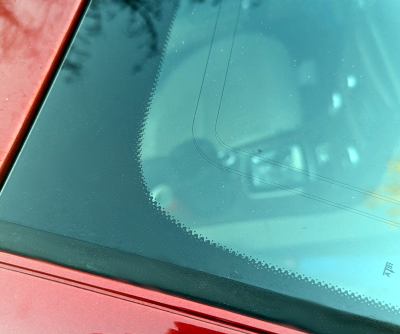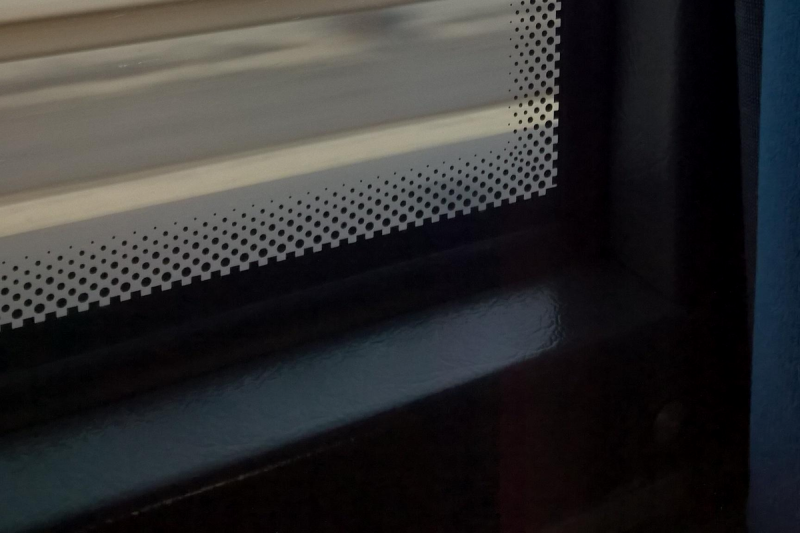You probably see a frit every day and don’t even notice it. What is it? You know the black band around your car’s windshield? That’s a frit (which, by the way, can also mean ingredients used in making glass) or, sometimes, a frit band. What’s more, it probably fades out using a series of dots like a halftone image, right? Think that’s just for aesthetics? Think again.
Older windshields were not always attached firmly, leading to them popping out in accidents. At some point, though, the industry moved to polyurethane adhesives, which are superior when applied correctly. However, they often degrade from exposure to UV. That’s a problem with a windshield, which usually gets plenty of sunlight.
The answer is the frit, a ceramic-based baked-on enamel applied to both sides of the windshield’s edges, usually using silk screening. The inner part serves as a bonding point for the adhesive. However, the outer part blocks UV radiation from reaching the adhesive. Of course, it also hides the adhesive and any edges or wiring beneath it, too.
But the Dots?

What about the dots? Well, as you might expect, when the black enamel blocks UV, it turns into heat, so you now have, potentially, a hot edge and a cooler center. That’s not a good thing for glass and can cause deformation. At best, it might cause optical distortion. At worst, it might crack the glass. The dots, then, cause an even temperature gradient to form instead of a sharp transition.
This is especially important because of the way windshields are made. They start as ordinary flat glass but are placed in an oven and bent against a jig. There are usually two pieces of glass, one slightly larger than the other. Finally, the two pieces of glass are laminated together with a sheet of polyvinyl butyral — an optically clear, flexible, and sticky material that keeps the glass from shattering.
No Frit?
Some windshields have a tint in them that block UV and don’t need a frit. In addition, there are advanced adhesives that don’t need protection from UV. But for most cars, the frit is a visible reminder that someone puts a lot of thought into every piece of an automobile. Many cars now have frit behind the rearview mirror to help block sunlight in that area.
Older cars didn’t have frit bands because they used a gasket to seal out water and a metal trim plate over the edge of the windshield. That had a bad habit of letting the windshield fly free in certain kinds of accidents, though, so you won’t find that on modern cars.
Glass is one of the oldest engineered materials around. The wipers are the next thing to notice about windshields, but we’ve already talked about those.

















Checked wikipedia in german and english, but in both frit means sintered glas, and the dust (before sintering), the sintered coat and the powdered (crushed after sintering for use in other areas) are all called frit.
So i will keep in mind that frit is the black enamel coating on glass corners used as uv blocker and also extra friction surface on windshilds.
Also that oldtimers are in case of crashes a windshild loaded gun. Sounds like from Looney Toones.
But when was frit first used for car windshields ? History first use.
That was a fantastic quick hit of tech!
Bravo!
Agreed! Thanks, Al and Hackaday!
I had a 89 Mercury with weak A/C, the frit got famn hot in the sun. I covered the frit with silvery tape and painted the roof white, A/C had an easier time.
“That had a bad habit of letting the windshield fly free in certain kinds of accidents, though, so you won’t find that on modern cars.”
Well there goes the kick-out panel. Might have to start using explosives.
Yes, I mentioned to a Safelite tech a few years ago that kicking out the windshield was taught as a way to get out of a car if the doors weren’t working.
His reply was to the effect, that doesn’t work in modern cars.
I had my windshield on an old car tinted with some ceramic tint that allowed 95% of light through, but blocked a good bit of heat. There’s laws against windshield tint but nobody saw it or complained.
I am sure, a transparency of 95% is enough. Normal home windows, especially 3 pane windows, block a significant portion of the light just by the 6 reflection surfaces, each reflectingabout 5% of the light.
Now someone explain why German rear-view mirror leak oil…
That is the gel pack from the rain sensor leaking..
Maybe cooling? One of the first led eddison 27 socket Bulbs that i bought leaked after 5 years. The sealant silicone leaked, pertroleum (it smells like it and its fells oily) droplets felt down. It was the cooling liquid for the circuit.
Is it a bmw (bayerische motoren werke) ? Could be the dimming oil.
Look at this forum, there is also a repair video.
https://www.m5board.com/threads/repairing-dimming-oil-leak-from-rearview-mirror.77575/
What the actual hell. This is why novices like me believe in headlight fluid.
Ironically, due to no-longer-sealed beams, I had a 1982 VW Rabbit with headlight fluid. It also leaked oil, although not from the mirror.
> a bmw (bayerische motoren werke) ?
“Bei Mercedes Weggeworfen”
But..but..BMW drivers don’t use turn signals. They use hand signals and there’s only one hand signal they use (hand out of the window, middle finger extended and visible to other motorists).
Most of the former BMW drivers switched to Audi I noticed.
As a result I had the odd experience recently of seeing a very polite and calm BMW driver in traffic.
This looks like some kind of ferrofluid (some magnetic nano particles in oil). Could be rust in nano size. Maybe you can replaced it, but if an accident happend and then the insurance… better not. Also how to seal it again.
But dimming with ferrofluids could be interesting for sun spotting. I wonder if i can build one for my telescope?
Thanks; I’ve often wondered!
Love the article, I’ve installed many windshields and always wondered about the dots in n the frit, now I know!
I often feel like my youtube suggestions and hackaday’s writer’s are one in the same. Even with a video like this that’s from some small channel made for an industrial adhesives manufacturing company, i get suggested videos hackaday is about to cover a day or yeo early at an alarming rate. Just saw this video yesterday.
I wonder what’s going on with YouTuber’s backend such that I’m almost wholely unable to break out of the silo of channels it suggests things from, but still get he same suggestions that end up on HaD 1-4days before they end up here so often.
Huh. Just noticed there’s no link to the video i was thinking this post was based on. But it’s not mentioned in the article, despite being very similar in content. Maybe I just happened to get fed the same inspiration/source as Al Williams?
https://youtu.be/Vk_HQByQ6Ck?si=i7Y9BwuD4GKQXuiH
There was just an article about this on the adafruit website, but when I clicked on it there was a video and a bunch of ads and links to other “articles” but there was no write up or anything else that I could easily find so I closed the tab. I don’t need to watch a video when a couple of sentences would have told me everything the headline hinted at.
So anyway, I’m glad I found this article cause the other one was a bust.
Maybe it’s just the frequency illusion, but it does feel weird when you come across some unusual thing you never pay attention to in several seemingly unassociated places rapid-fire like that.
I also saw that video one or two days ago!
So there are ways of gluing windows in and giving maximum visibility out the windows for safety’s sake. The area of some of the shades can hide a bicyclist coming from the side.
“baked-on enamel applied to both sides of the windshield’s edges”
Never seen it on the outside of the edge, that would be an absolute riot to clean. What did the author mean here? What are they defining as the edge? Images speak a thousand words.
My cars are from the 70’s – when a windscreen is replaced, I put silicone sealant in the rubber before the glass because they always bloody leak! Nice to think it may stop it from popping out in a crash too.
What if you ruffed the windshild edges, that silicone can stick to it better? Would sanding the glass work or must it added a backed on extra coat?